The program for a low level of formatting flash drives. FAT32 and low-level formatting flash drives
To date, mankind has almost completely abandoned various kinds of disks and switched to flash drives. With the development of most modern laptops, manufacturers do not even think about the integration of the drive. All this has its own reasons, from reliability to convenience. There is no need to carry around 20 discs if you can take just one small item that will hold 100 times more information than any disk - a flash drive.
In this article we will talk about how to properly format a USB flash drive and why it is needed at all.
Why format a USB flash drive?
Formatting is useful, as it not only cleans the flash drive from the information, but also treats file system. How?
In fact, everything is very logical. The formatting process itself involves the creation of data access structures - file system structures. At the same time, the ability to access information that exists before formatting is lost (as a rule, some part can be restored).
Thus, if trouble happened to our flash drive, we can, in fact, reset it. We can say that formatting is a guard against all problems (unless of course there is no need to save information).
How to format a USB flash drive?
You need to insert the USB flash drive into the USB connector, find the disk that appears in My Computer, click right click mouse and select "Format":
Just do not confuse the flash drive with a local disk, otherwise you will lose all your files!
Now let's see what kind of formatting we need:
If the flash drive does not appear next to the local drives, read the item "Formatting via the control panel"
The formatting process is divided into:
- Low level;
- High level.
High-level is divided into:
- Fast;
- Complete
Fast formatting
- Removes all data from the flash drive, but with the ability to recover them;
- With not 100% probability, but it is possible to remove viruses;
- Changes the file system;
In this case, the process itself is carried out very quickly (usually not more than a minute). However, it is far from a fact that you can fix the problems of the flash drive, if any. If everything works fine for you - fast formatting is the best option.
The standard way to perform quick formatting is to connect the USB flash drive to the PC, go to “My Computer” - right-click on the drive and select “Format”:
In the window that appears, make sure that there is a tick "Formatting methods" - "Quick": 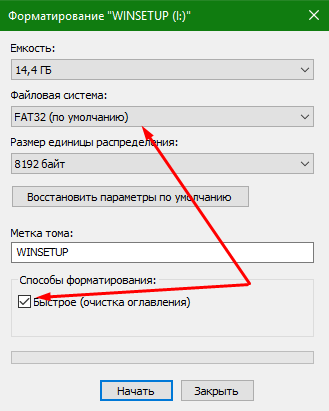
You can also change the file system (which one is better to use, I will tell further).
Pressing the “Start” button will format the USB flash drive: 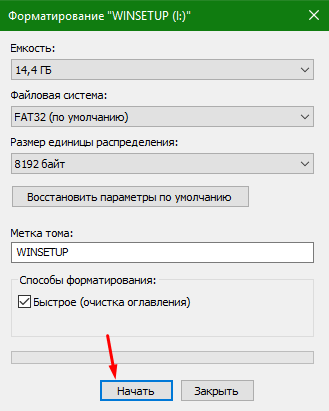
If you are sure that something is wrong with your drive, for example, it is not visible in My Computer, then 99% will help you with full formatting.
Full format
- Removes all available information on the flash drive permanently;
- Virtually no virus will survive;
- Normal operation is restored (everything is again normally shown when connected to a computer, the initial operation speed is returned);
- File system changes
The process of full formatting takes significantly longer than a fast one (usually at least 20 minutes). This gives a great guarantee of reviving the flash drive (if you had any problems), but, again, not 100%.
The standard way to perform full formatting is the same as for quick. We connect the USB flash drive to the computer, click the right mouse button, select "Format": 
In the window that opens, uncheck the “Fast” and click “Start”: 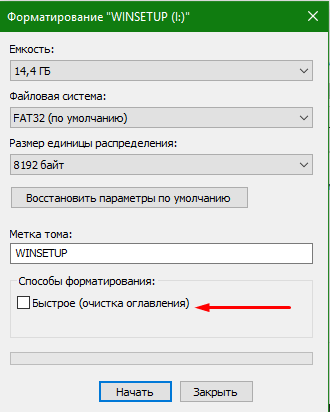
After that, we will have to wait (much more than if we used fast formatting).
What file system to choose when formatting
As in any business, the choice should be made based on needs. You have a choice of FAT32, NTFS, exFAT. Each fits its own type of tasks:
- FAT32 - has an unpleasant drawback in the form of restrictions on the transfer of files weighing more than 4 GB, but it works faster than NTFS;
- NTFS is the most popular file system with no restrictions on the amount of file transfer. Created specifically to store a huge amount of data. The best way, if you do not know what to choose and want everything to work without failures and restrictions.
- exFAT is a system developed by Microsoft as a more advanced descendant of the FAT32 system, retaining the advantages of the ancestor and incorporating the ability to transfer files weighing more than 4 GB. Of the minuses - possible incompatibility with various kinds of equipment, software (for example, windows XP cannot work with this file system).
Formatting via control panel
If you have suffered the problem of the invisibility of the flash drive in "My Computer" when you connect it, then this solution is for you. You need to go to the "Control Panel", there find the item "System and Security": 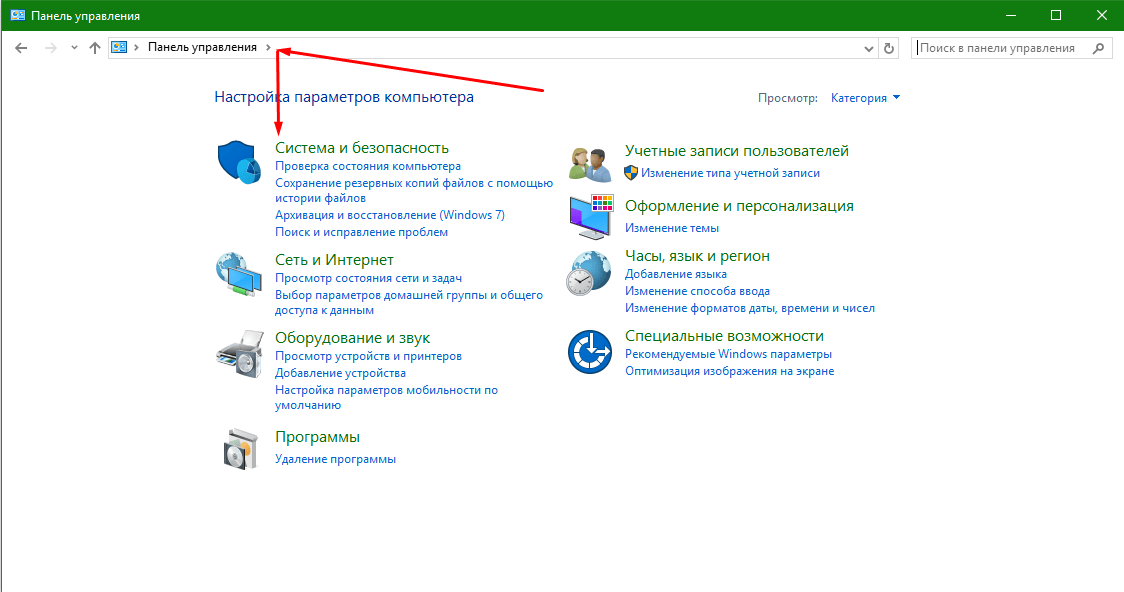
And already there to find "Administration": 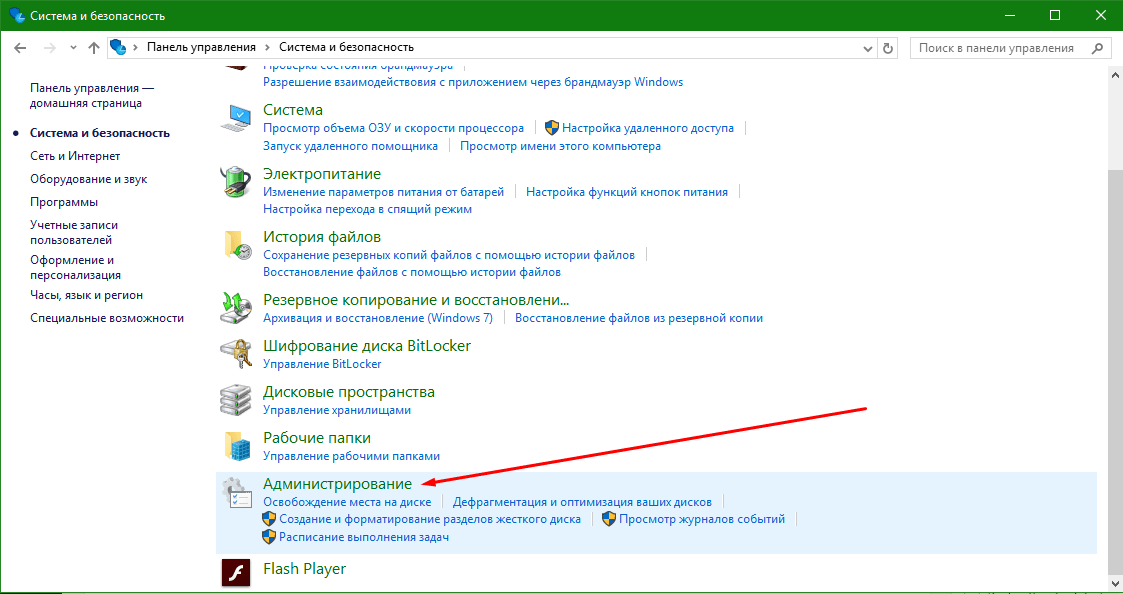
If you are using windows 10, like normal guys, press the key combination “win + s” and in the appeared search enter “Control Panel”. In order not to scour in manual searches all over the computer!
Use the capabilities of the system! And if you are not yet using windows 10 -
Find and open Computer Management: 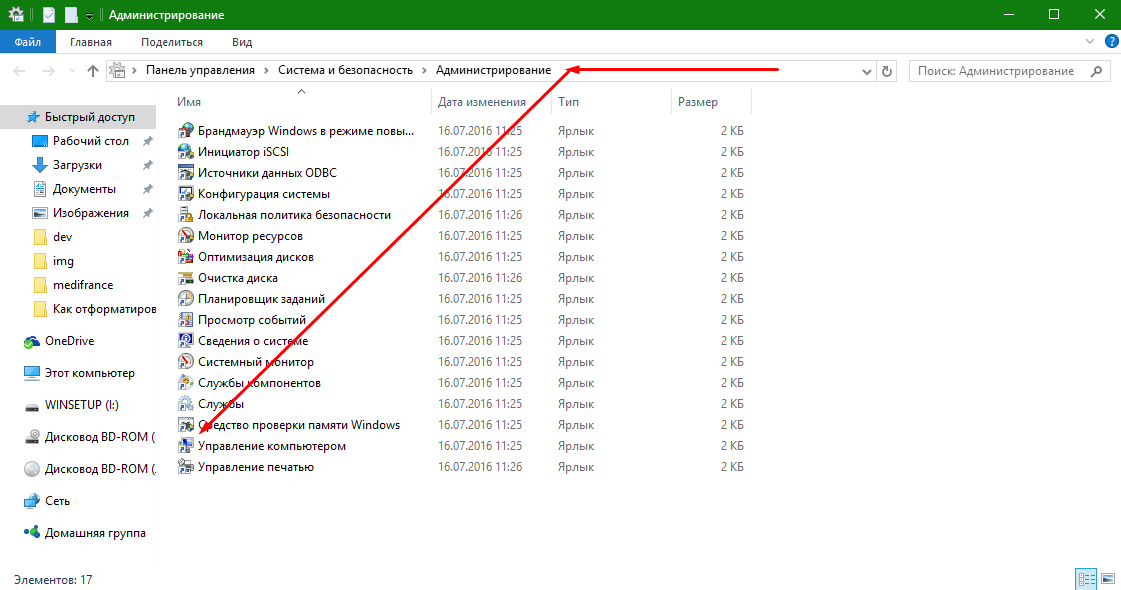
In the left column we find "Disk Management" and go there. It will display all the drives connected to the computer (even those that are not in My Computer). 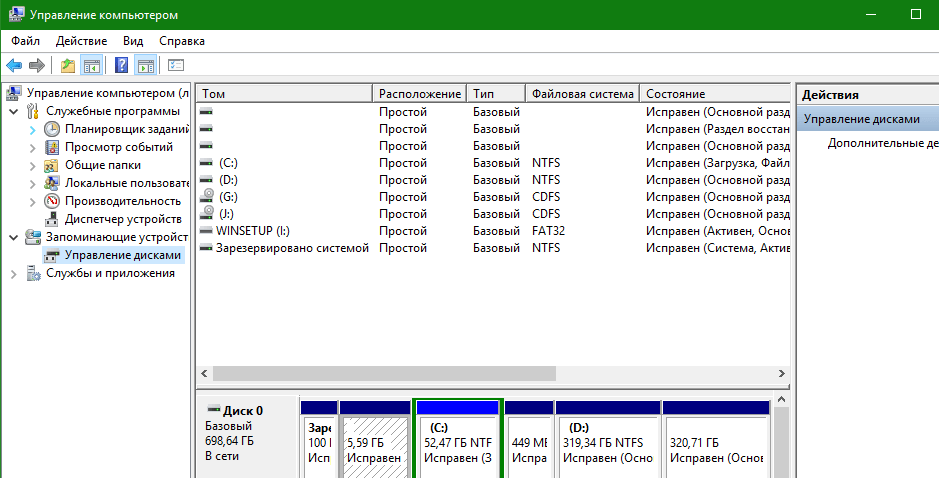
Now you need to select the USB flash drive, right-click on it and select "Format": 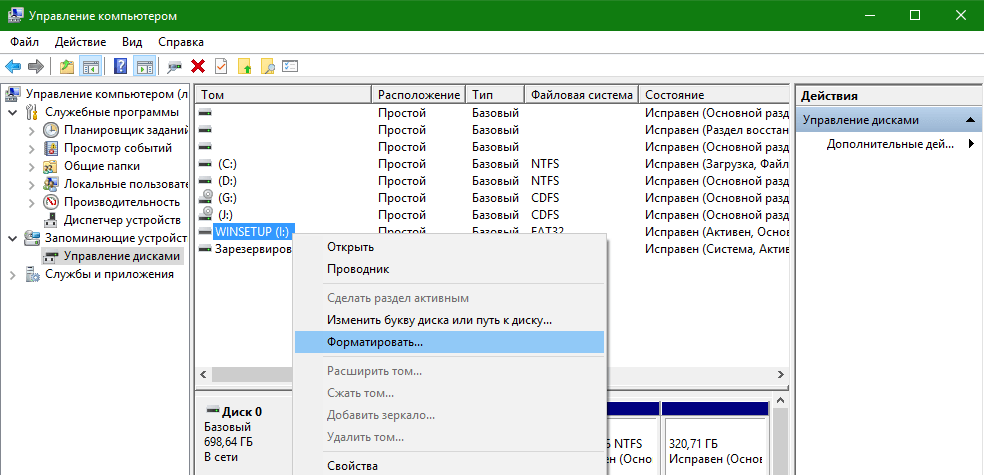
Formatting a flash drive via the command line
To perform formatting through command line You need to know the exact letter assigned to the flash drive. Otherwise, you may accidentally format your local disk. You can find it through the "Control Panel" - as in the previous section. Or through "My Computer", if the flash drive is displayed.
You need to run a command prompt on behalf of the administrator, to learn more about this process, read the relevant article - “
Typically, formatting is required when the media is in FAT32 format and you cannot store files larger than 4 GB, although it says that its capacity is 12 GB. You should change the format to another. If you have such a case, go directly to the third method.
In general, formatting is needed for:
- Delete all information.
- Virus clearance.
- Create bootable media.
- File storage more than 4 GB.
- Bug fixes.
By the way! If the media began to work slowly, then formatting will help speed it up.
When something is removed from the carrier, there is an empty space or cluster. After formatting, these empty places are removed and due to this the operation of the device is accelerated.
Attention! Formatting deletes all data. Save them in advance if they are needed.
There are 2 types of formatting: fast and normal. If you use fast, then the data can still be restored, and if the usual - is no longer the way rewriting occurs at 0. I will show you 3 ways to format the USB flash drive.
For more information about formatting flash drives, you can also see in this video.
Standard in Windows
The easiest way is to take advantage of the standard features that are already built into Windows. Open My Computer \u003e\u003e Select Device \u003e\u003e At context menu select Format ...:
- The file system is the latest NTFS standard. Older FAT32, exFat, FAT16 and others.
- A cluster is a data storage unit. It is recommended to leave the default.
- The volume label is the name of the carrier. You can specify any for convenience.
- Fast - you can recover data. If removed, it will be impossible.
More about the cluster. It indicates the minimum size of the file stored on the media. For example, if the file is larger than the size of 4096 bytes, which you specified, it will be divided into parts. And the more parts will be - the slower it will be read.
Therefore, if you are storing large files, choose the largest cluster size. If small, then the smallest.
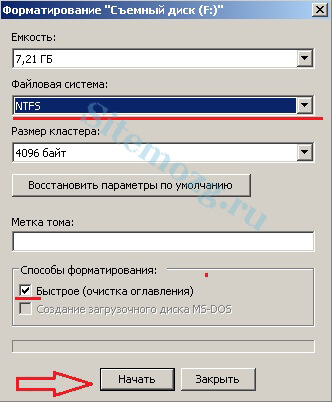
It is advisable to use full formatting in the same way as with the fast one in essence it does not occur. Just the data that is left, begin to overwrite new ( replaced).
Command line
This method can be used if for some reason the first one fails to be executed. Open the run line ( windows + R) and configure the command to format for yourself:
format F: / fs: FAT32 / v: sitemozg / Q
This is what it means:
- format - team name.
- F - the letter that indicates the name of the carrier.
- / fs: - file system ( FAT32, NTFS).
- / v: - name.
- / Q - quick formatting.
Look for the letter in the interface "My Computer" as in the image below:
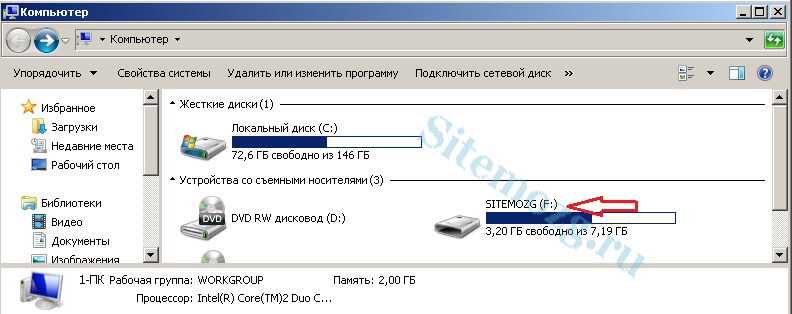
After setting up the command for your carrier, use it in the execution line.
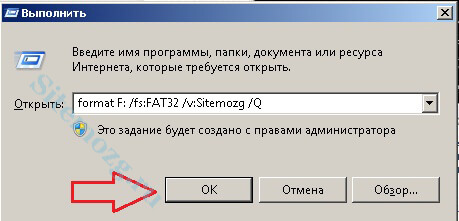
Then insert a USB flash drive if it is not already inserted and press the ENTER key.
Wait until the end of the procedure. After it should appear the corresponding window with the results.
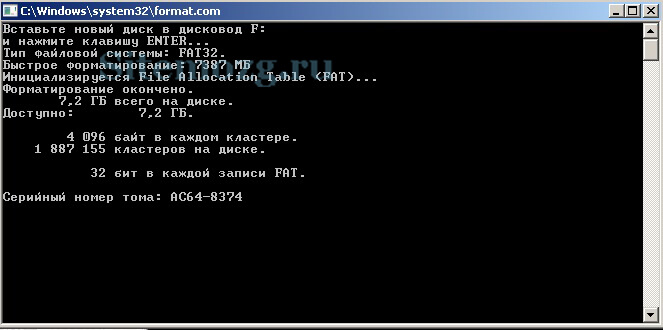
FAT32 format in NTFS using the program
The first two methods will not allow you to format in NTFS, an error will appear.
For this you need to use third party program. I suggest to download. Run it, select NTFS and quick format ( quick format) in the options as in the picture below.
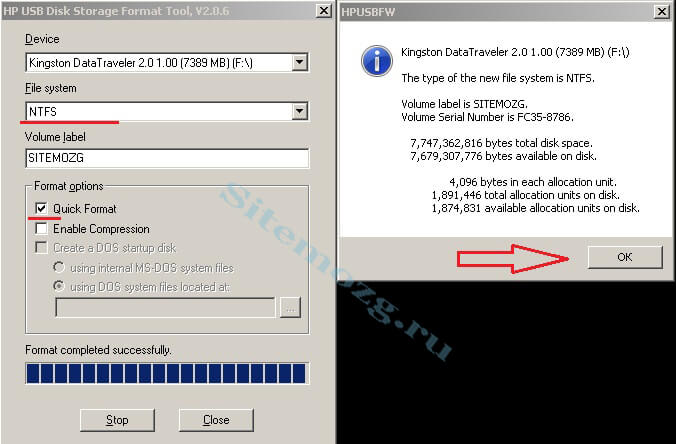
At the end of the process a window will appear with the results. It took me less than a minute and there was a successful change from FAT32 to NTFS.
It is always better to use NTFS. It is safer and has fewer restrictions on it. However, this format may not work on older devices due to the lack of support ( for example in tape recorders), and FAT32 is ideal for older devices.
There are many programs, but this will be quite enough.
How did you manage to format the flash drive?
Hey. Today I will write a small instruction about how to format a flash drive on your computer. Flash drives, beautiful devices that have tightly entered our lives and are slowly squeezing out the CD and DVD discs. I do not know, maybe these are for the better, because a flash drive is more practical, but like any other device it can fail, and the first thing we need to do is try format her. But before formatting a flash drive, we need to clarify something:
Why do I need to format the USB flash drive?
Good question, let's try to answer:
- For example, you have a large flash drive, and you need to clean it in one fell swoop. Then formatting is the best option.
- The flash drive suffered from viruses, as a rule, flash drives are very well infected and then the best way This scan it with antivirus or format. There is one such virus (I don’t know exactly what it is called) that does all the folders on the flash drive with the extension .exe and the information in these folders becomes inaccessible. I had such a case more than once, and I had to format the flash drive.
- If you see problems with writing to a flash drive, you can try to format it.
- If you want to change the file system of the flash drive with FAT 32 to a newer NTFS. NTFS system It has some advantages, for example, it allows you to work with large files, this is especially true if you have a large USB flash drive. In this case, you can format the USB flash drive in NTFS. In the instructions below I will write about it.
You must remember that formatting will destroy all data from Flash Drive!
1. Insert the USB flash drive into the computer.
2. Go to "My computer" and find our flash drive.
 3. Click on it with the right mouse button and rip out "Format" This window will open:
3. Click on it with the right mouse button and rip out "Format" This window will open:
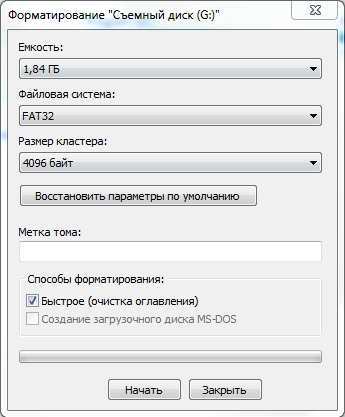
4. Set all the necessary parameters. Here we need to change (not necessarily) only "File system" as you can see there is FAT 32. But if we need, then click on the drop-down menu and select NTFS.

When all parameters are set, click “Start”. We agree to the warning and wait until the formatting process is over.
As you can see there is nothing complicated and everything is very simple. Just do not forget that formatting will erase absolutely all files from a flash device and it will be possible to restore them, but not everything is very difficult.
Everything, now your flash drive as new. Here is such a simple advice that I hope you come in handy. Good luck!
We understand how to format the flash drive in ntfs or fat32
In this article we will sort out such a question how to format the flash drive in the file system we need - ntfs or fat32. The question is very frequent and not always clear.
And not even safe for your data. When you do the formatting you need to know exactly what you are doing and in what order, so as not to lose the necessary files.
The fact is that in the process of formatting (full, not fast), not only data is deleted from the flash drive, but also a partial repair of its file system.
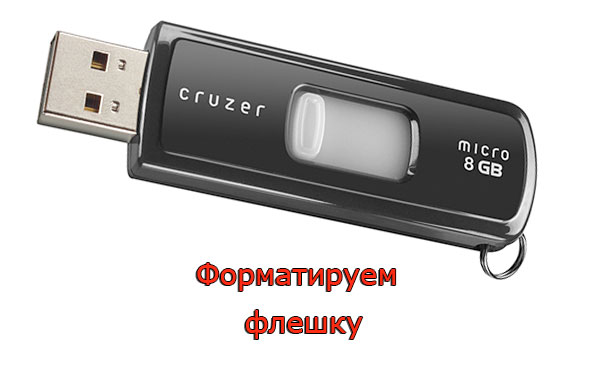
Therefore, having formatted the flash drive, we will not only clean it, but we can also improve its work, if errors and malfunctions start to happen to it.
We will deal with this issue in this order:
- What is formatting?
- Why format a USB flash drive?
- Well, in addition - why when writing to an empty flash drive, it says that there is no place and why should I change the file system from fat32 to ntfs?
So what is formatting? Formatting, in simple terms, is the process of deleting data overwriting the file system.
And in short, it's just complete removal data from a flash drive.
What we need to format the flash drive in ntfs:
- If the flash drive does not read or does not open, then formatting can solve this problem.
- If on a flash drive there are viruses , and the antivirus does not see them, you can simply format it, thereby removing all viruses. Just keep in mind that all files from the flash drive will be deleted too.
- If you need to change the file system of the flash drive, then in the process of preparing for formatting you can change it and the formatted flash drive will be with the file system that you specified in the beginning of the process.
- Slow work flash drive. This happens because the file system on it over time accumulates errors. In order to get rid of them you need to complete the formatting, read about it below.
What are the types of formatting?
There are two types of formatting:
- Low level
- High level
Low level formatting this is the basic data markup, it is performed at the factory.
Outside the factory, it is almost impossible to do it, despite the fact that sometimes programs that conduct low level formatting. About this type of formatting everything, because it is not interesting to us, it is carried out at manufacturing plants.
But high-level formatting is more interesting for us. This formatting we can quite spend at home just sitting at the computer . It is divided into:
- Fast
- Complete
How fast formatting is different from full, we learn by considering their capabilities.
And so with quick formatting:
- All data from a flash drive is deleted, but it can be recovered, as it is possible to recover data from a flash drive, read the note recover data from a flash drive
- Together with the removal of all data viruses are also removed
- It is performed very quickly, usually not more than a minute.
With full formatting:
- All data is permanently deleted from a flash drive; it is extremely difficult to recover it; it is almost impossible to restore it at home.
- You can change the file system
- More likely all viruses and files are deleted too.
- The lead time is usually from 40 minutes to 1.5 hours.
- And, most importantly, with full formatting, it is sometimes possible to restore the normal operation of the flash drive. For example, if it is not detected or works slowly. But again, only sometimes.
What are the ways of formatting?
You can format the USB flash drive as easy in windows , and special programs. It is clear that in windows, namely through my computer, it is easier and easier to format a USB flash drive.
Special programs are needed if, through the easiest way that is presented in this article, it is impossible to perform
But it happens that through my computer it is impossible to either format or change the file system. In this situation, and you need to use special programs for formatting flash drives.
In this article we will discuss how to format a flash drive without special programs. We will do this through "my computer" or windows 7 "computer".
This is the most important icon on the desktop. We insert the USB stick into usb input computer or laptop and go to the "computer" on the desktop.
Here we see we have a flash drive under the letter I:

To format it you need to click on it with the right mouse button and select “format” there:

This is very important, because if you inadvertently select here not a USB flash drive, but a hard disk drive, it will be formatted and you will lose all data on it.
If you, for example, know that your flash drive has a capacity of 8 gigabytes, it means that this line should be 8, or almost 8. A little less, the main thing is not much more.
Now an important parameter that answers the question of how to format a flash drive in ntfs. Now comes the very important parameter for us is the file system.
If possible, you should always install the NTFS file system
But sometimes it happens that by putting in initial settings NTFS, the formatting cannot complete to the end and writes “formatting is not complete.”
The reason for this is very often the fact that you set NTFS in the initial settings. But do not worry just start all over again and in the initial settings, put FAT32.
Then comes the size of the cluster, put it there automatically or do not touch anything at all.
Well, the last important parameter is “formatting methods”.
In our case, in the picture below, there is a check mark in front of the “quick”. What it means fast described above.
If we remove the check mark, the formatting will be “full”, which is also described above:

If you set the desired settings, then click "Start". when prompted to delete all files, click "Ok":
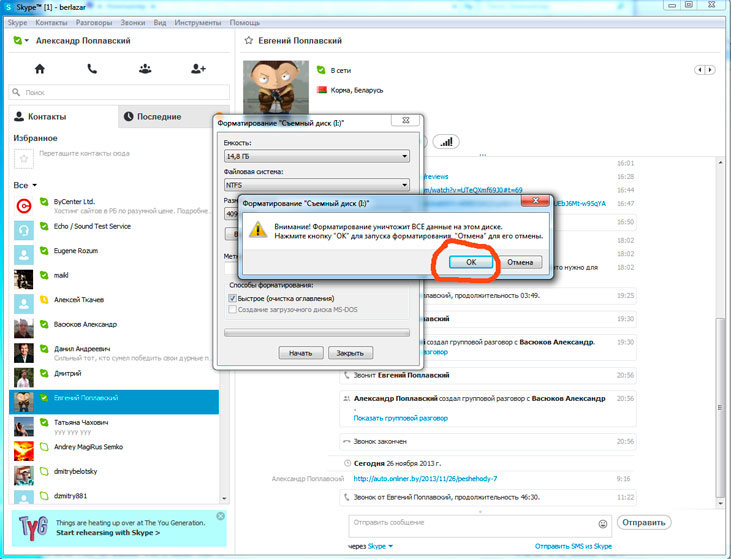
At the end of the formatting, this window will appear:
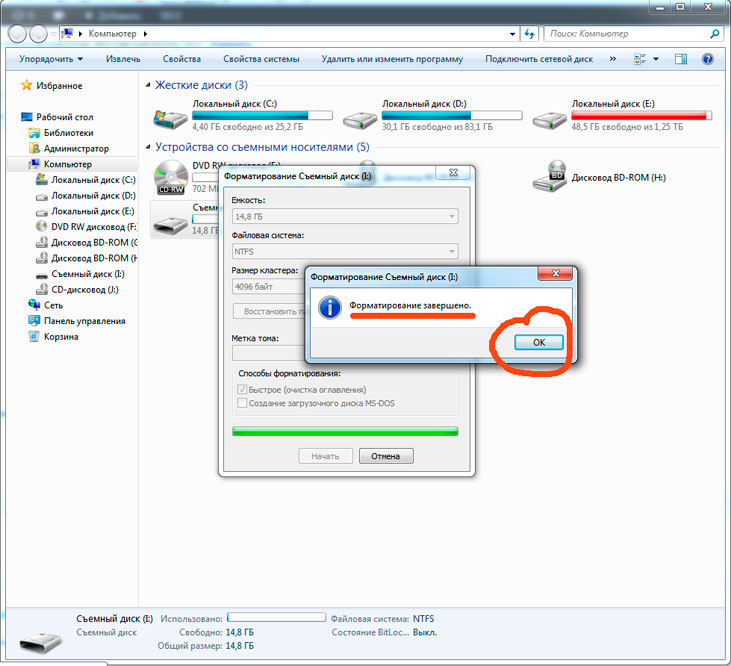
All you formatted a flash drive and can already use it.
And the last question - why, when writing to an empty flash drive, does it say that there is no room and why in this situation do I need to change the file system from FAT32 to NTFS?
And so why he writes that there is no space on the flash drive, although it is empty or there is enough space.
The problem is that the flash drive is a file system FAT32, but it can not work with files the size of which is more than 4 gigabytes.
So it turns out that when you try to burn a movie more than 4 gigabytes to a USB flash drive, a message appears stating that there is no free space.
To solve this problem, you need to change the file system from FAT32 to NTFS. It is easy to do, as described above.
So we disassembled the question of how to format a USB flash drive.
